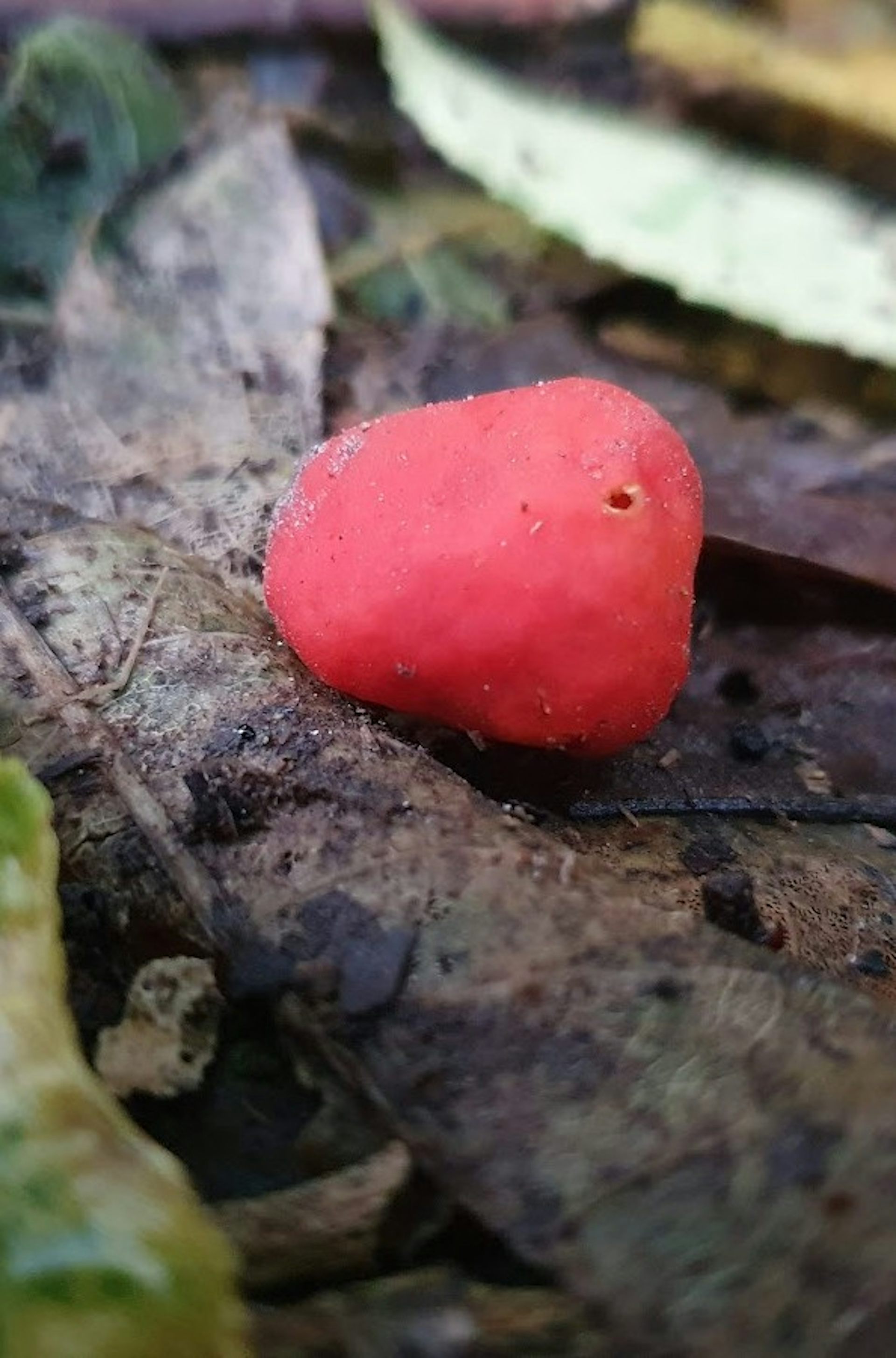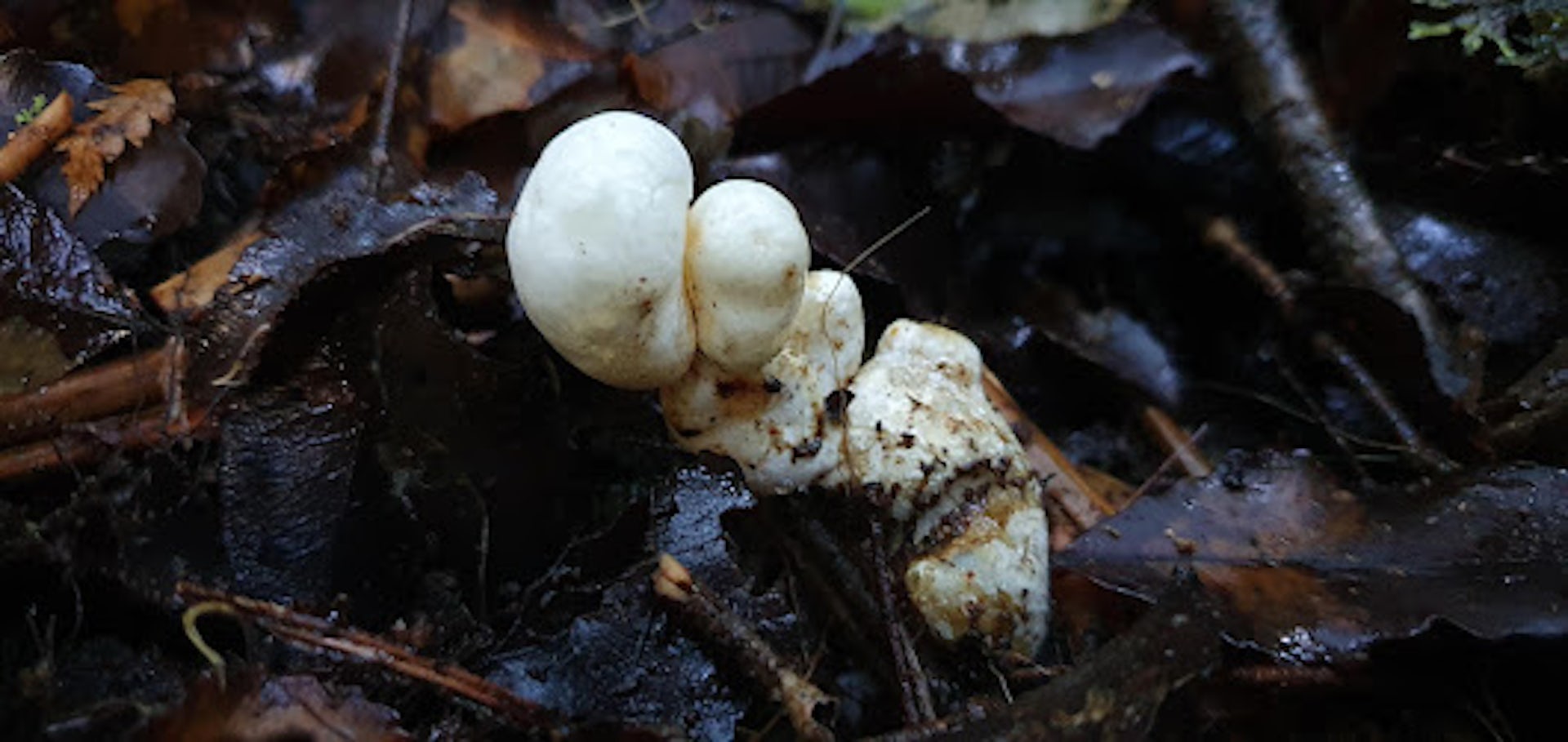Colourful fruit-like fungi and forests ‘haunted by species loss’ – how we resolved a 30-year evolutionary mystery
Fungi, like some primitive plants such as ferns and mosses reproduce with spores - tiny packages that contain the entire genome of the parent which have the capacity to grow and develop into a new adult able to produce spores of its own. The key to success is getting those spores dispersed and how a fungus manages that will depend on the environment in which it lives and reproduces.
Most fungi use wind dispersal, their spores being light enough to be carried considerable distances but where they land is a matter of chance, so must wind-dispersed fungi produce millions of spores to give them a good chance of just one or two landing in a suitable place.
A few others have evolved a different, more targeted strategy such as being eaten by animals and excreted in their faeces. This increases the chance of being deposited in the same environment in which the parent fungi lived as the dispersing animal also lives in that environment. This is the method adopted by truffles which produce their fruiting body (where the spores are produced) underground and emit a scent which is attractive to the target animal (pigs, dogs, etc.) which dig up the fruiting body and eventually disperse the spores. This is probably the reason that humans like the taste of truffles, although we lack the ability to sniff them out for ourselves, but possibly an early ancestral species could.
But what happens to these fungi if there are no mammals, other than bats, as was the case with New Zealand before humans brought their commensal species with them? This is the subject of an article in The Conversation by three experts: Jamie Wood, Senior Lecturer in Ecology and Evolution, University of Adelaide, Australia, and Amy Martin, Post-Doctoral Researcher in Evolutionary Ecology and Anne Gaskett, Associate Professor of Biology, both of the University of Auckland, Waipapa Taumata Rau, New Zealand.
Their article is reproduced here under a Creative Commons license, reformatted for stylistic consistency:

Colourful fruit‑like fungi and forests ‘haunted by species loss’ – how we resolved a 30‑year evolutionary mystery
Amy Martin, CC BY-SA
Jamie Wood, University of Adelaide; Amy Martin, University of Auckland, Waipapa Taumata Rau, and Anne Gaskett, University of Auckland, Waipapa Taumata Rau
Most fungi need only wind or water to disperse their spores. But some, including truffles, need a little help from animals.
Usually, truffles and truffle-like fungi (which don’t belong to the truffle genus, but are otherwise similar) are dull-coloured and grow underground.
They use scent to attract mammals, which eat them and disperse the spores across the landscape in their dung. This ancient truffle-mammal relationship is why truffle pigs and truffle dogs (and many humans) love eating these fungi.
But Aotearoa New Zealand had no native land mammals to disperse truffles. Our new study resolves a 30-year mystery about whether fruit-eating birds might instead have taken this role.
NZ’s unusually colourful truffle-like fungi
In most ecosystems, truffles are eaten by small mammals, especially rodents and marsupials, which are critical for fungal dispersal and forest health.
In the 1990s, mycologist Ross Beever noticed something odd about truffle-like fungi growing in New Zealand.
Many had brightly coloured fruiting bodies which emerged above the forest floor, essentially mimicking fallen fruit. Because of New Zealand’s lack of mammals (with the exception of bats), Beever hypothesised that these characteristics had evolved to attract birds as spore dispersers because they rely more on vision than scent to find food.
Beever and his colleague Teresa Lebel detailed this fascinating hypothesis elegantly in 2014, but it remained untested for three decades.

With no land mammals to eat them, truffle-like fungi rely on colour to attract birds.
Amy Martin, CC BY-SA
In our research, we asked whether New Zealand really has more brightly coloured truffle-like fungi or whether we are simply paying more attention to them and under-appreciating the dull ones. And we investigated if there was a link between their distribution and fruit-eating birds.

New Zealand has more colourful truffle-like fungi, especially red and blue ones.
Amy Martin, CC BY-SA
These data were analysed alongside environmental factors (such as precipitation and temperature) and biological aspects (such as forest cover and the presence of fruit-eating birds) that might help explain any spatial patterns.
While colourful truffle-like fungi are also found in South and Central America and Australia, our results confirmed New Zealand has a much greater proportion compared to other landmasses. This is especially true for red and blue coloured species.
We also found that, across the world, regions with more fruit-eating birds also had more colourful truffle-like fungi.
Birds, truffle-like fungi and trees
Until recently, birds were thought to have a limited role in dispersing truffle-like fungi.
But this changed in 2021, when a study of faecal samples from two fruit-eating bird species from Patagonia (Chucao tapaculo and Black-throated huet-huet) found DNA and spores from a wide range of fungi, including truffle-like fungi.
The research team also observed both bird species uncovering truffles on the forest floor, thereby demonstrating the important role birds could have in fungal dispersal.
A further finding of the Patagonian study was that many of the truffle-like fungi detected in the faecal samples are part of the underground network of fungi-plant root interactions known as mycorrhiza.
In New Zealand, most colourful truffle-like fungi are also mycorrhizal with locally dominant forest trees such as beeches and podocarps. These fungi make it easier for the trees to access water and mineral nutrients from the soil. Therefore, birds that eat truffle-like fungi may not only be important for the fungi themselves, but for entire forest ecosystems.

Most truffle-like fungi are part of the underground network interacting with plant roots.
Amy Martin, CC BY-SA
The results of our study support the idea that colourful truffle-like fungi are adapted for bird dispersal, and that they are more common in New Zealand than elsewhere in the world.
Yet, paradoxically, the number of observed instances of local birds eating truffle-like fungi can be counted on one hand. Why is this? The answer may lie in New Zealand’s legacy of extinction.
Around one third of all bird species on the mainland and offshore islands have become extinct since the first human settlers arrived during the 13th century. Many more have had their populations reduced to the point of functional extinction. Among these are many large birds known to have eaten fruit, including nine species of moa and kākāpō.
In 2018, a study of DNA from ancient dung of moa and kākāpō found evidence these birds once ate mycorrhizal truffle-like fungi. The loss of such birds from New Zealand’s forests represents the end of millions of years of co-evolution with fungi.
These bird-adapted fungi may now remain as ghosts of past mutualisms – the association between organisms of two different species in which each benefits – much like the large tropical fruit once eaten by gomphotheres, an extinct group related to modern elephants.
How will our forest trees cope with the loss of these bird-fungus interactions, which help facilitate plant growth on bare soils? Can introduced animal species act as surrogate dispersers for native fungi?
The implications for forests, haunted by species loss, remain unknown. With continued research and conservation efforts, however, we can better understand and support the balance of our forest ecosystems to ensure the rich and unique biodiversity of New Zealand’s forests endures for generations to come.
Jamie Wood, Senior Lecturer in Ecology and Evolution, University of Adelaide; Amy Martin, Post-Doctoral Researcher in Evolutionary Ecology, University of Auckland, Waipapa Taumata Rau, and Anne Gaskett, Associate Professor of Biology, University of Auckland, Waipapa Taumata Rau
This article is republished from The Conversation under a Creative Commons license. Read the original article.
The fact that evolving species were in evolutionary relationships with now-extinct species is a feature of evolution that only makes sense in that context. It is seen, for example, in evolved Batesian mimicry where a harmless species resembles a harmful, toxic or distasteful species which no longer exists, so its striking coloration appears to be paradoxical. Not the design of an intelligent designer worthy of the name.
What Makes You So Special? From The Big Bang To You
How did you come to be here, now? This books takes you from the Big Bang to the evolution of modern humans and the history of human cultures, showing that science is an adventure of discovery and a source of limitless wonder, giving us richer and more rewarding appreciation of the phenomenal privilege of merely being alive and able to begin to understand it all.
Available in Hardcover, Paperback or ebook for Kindle
Ten Reasons To Lose Faith: And Why You Are Better Off Without It
This book explains why faith is a fallacy and serves no useful purpose other than providing an excuse for pretending to know things that are unknown. It also explains how losing faith liberates former sufferers from fear, delusion and the control of others, freeing them to see the world in a different light, to recognise the injustices that religions cause and to accept people for who they are, not which group they happened to be born in. A society based on atheist, Humanist principles would be a less divided, more inclusive, more peaceful society and one more appreciative of the one opportunity that life gives us to enjoy and wonder at the world we live in.
Available in Hardcover, Paperback or ebook for Kindle







No comments :
Post a Comment
Obscene, threatening or obnoxious messages, preaching, abuse and spam will be removed, as will anything by known Internet trolls and stalkers, by known sock-puppet accounts and anything not connected with the post,
A claim made without evidence can be dismissed without evidence. Remember: your opinion is not an established fact unless corroborated.